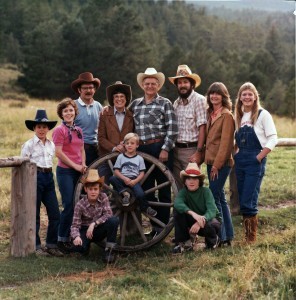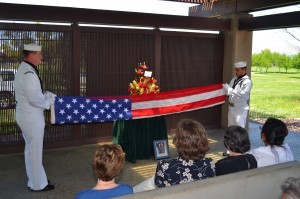S. Chris Edmonds's Blog, page 18
June 8, 2015
An Aligned Culture Creates Amazing Memories

1980 – Edmonds Family at Lost Valley Ranch
What is your dream vacation? Is it world travel, exploring countries, people, and places you’ve only read about? Is it visiting our vibrant metropolitan cities, seeing great performances in great venues?My “vacation” mindset comes from my non-profit executive career. I spent fifteen years taking kids to residence camps and travel camps. We traveled in school buses, vans, and – in the old days – cattle trucks.
Some of those kids had never been out of their own cities. We created teams to set up campsites, cook, serve, and clean up after each other. Many had never worked on an effective team before.
We challenged every camper to serve their families, friends, and neighbors in the years to come.
We awoke in some of the most beautiful places in the country – national parks, pristine beaches, rustic plains. We were coaching character while learning about our nation. It was gratifying work. For these kids and even for our adult volunteers, our trips were fabulous vacations.
I thought I knew a lot about creating inspiring experiences, but nothing prepared me for our family vacation in 1980 at the Lost Valley Ranch in Deckers, CO.
My dad called my brother and me to propose a family reunion at this dude ranch. Some of his business colleagues had raved about Lost Valley, so dad thought it’d be a great experience for everyone. The trip was mom and dad’s gift to us – and it’s a gift that continues today.
From the moment we arrived on the ranch property, everything the staff team did was focused on creating a relaxing and fulfilling experience for every guest. There were organized activities as well as a multitude of selections to suit one’s unique needs.
First, you went to the corral. The wranglers interviewed you about your horse sense and riding experience, and paired you with a suitable equine companion. Adults could choose from a variety of rides each day, some less strenuous, some more adventurous, guided by gracious and skilled wranglers.
Teens loved their full program of riding and even some “working ranch” activities, like moving the cattle from one grazing range to another. Younger children enjoyed activities that kept them engaged and entertained through the day.
Meals were delicious and served family style. Families typically ate breakfast and dinner together while lunches were served on the trail with your ride groups.
Evening programs featured the staff presenting a classic melodrama show or sing-alongs by the campfire. Staff members juggled multiple responsibilities – wranglers served time as cooks, wait staff sang and played each night as well as helped with trail rides during the day. Maintenance crew served as pool lifeguards.
There was nothing out of place, from the western cabins to the organized corral to the schedule of activities one could pick from. Every staff member was pleasant and focused on your needs. No question went unanswered. Every interaction validated your unique needs and opportunities.
It was an amazing time. The Lost Valley culture created a seamless vacation experience for us and our fellow guests. Mom and Dad brought us back two more times, in ’82 and ’84. It caused my family to fall in love with Colorado. Daughter Karin (on the right at sixteen years of age in the photo above) chose to go to college in Colorado. She married a local. Son Andy moved to Colorado a few years later and married a local.
We still talk about the great times we had at Lost Valley. Today, our home in Conifer, CO, is only 24 miles from the ranch.
Your team’s interactions with customers leave lasting impressions, as well. Are they as powerfully positive as those we experienced at Lost Valley – or not so much? How might you build an aligned team that consistently WOW’s your customers?
Share your insights on Twitter, Facebook, and LinkedIn.
Photo © S. Chris Edmonds Photography. All rights reserved.
 Podcast – Listen to this post now with the player below. Subscribe via RSS or iTunes.
Podcast – Listen to this post now with the player below. Subscribe via RSS or iTunes.
The music heard on my podcasts is from one of my songs, “Heartfelt,” copyright © 2005 Chris Edmonds Music (ASCAP). I play all instruments on these recordings.
Don’t miss any of Chris’ posts, podcasts, or updates – Subscribe Now!
Disclosure of Material Connection: Some of the links in the post above are “affiliate links.” This means if you click on the link and purchase the item, I will receive an affiliate commission. Regardless, I only recommend products or services I use personally and believe will add value to my readers. I am disclosing this in accordance with the Federal Trade Commission’s 16 CFR, Part 255: “Guides Concerning the Use of Endorsements and Testimonials in Advertising.”

June 1, 2015
Demand Ethical Behavior
 This week the world of football (soccer in the US) was shocked by the US Department of Justice indictment of 14 defendants for alleged FIFA kickbacks of more than $150 million over the past twenty years.
This week the world of football (soccer in the US) was shocked by the US Department of Justice indictment of 14 defendants for alleged FIFA kickbacks of more than $150 million over the past twenty years.
What was more shocking to me was the response of the FIFA president, up for re-election within hours, who said, “We cannot constantly supervise everyone in football . . . you cannot ask everyone to behave ethically.”
What an amazing admission by Sepp Blatter (who won re-election, despite the “distraction” of the arrests). Blatter believes he is not responsible – nor is any leader – if someone in their employ breaks the law (or bribes officials or launders money, etc.).
This is not just a FIFA leadership problem. Many company, region, department, and team leaders around the globe believe the same thing: “Leaders cannot ask their people to behave ethically. I am not responsible for whether my leaders or team members behave in an ethical manner.”
These issues are prevalent across the globe. For example, the CFO of the Phoenix VA hospital testified last June that the hospital environment was toxic, the “most dysfunctional place I’ve ever worked in my life.” She reported she was subject to sexual harassment, racial slurs, and bogus investigations during her two years there.
Phoenix VA administrators didn’t just focus on harassment of the CFO. They were apparently preoccupied with accusing and investigating one another for years – all while veterans awaited care in a system of backlogged appointments and fabricated wait-time reporting.
Here’s another example. In Denver, a former sheriff’s department investigator reported that he was told by his captain to avoid logging into evidence a videotape of inmate mistreatment that occurred last month. If the tape wasn’t logged into the evidence system, the incident would not be investigated further. The department has suffered systemic problems including poor training of officers and mistreatment of inmates for years.
The reality is that leaders are, indeed, responsible for the creation of productive workplaces that treat everyone with trust, respect, and dignity in every interaction.
Where leaders create clear performance expectations and hold people accountable for those, results and profits steadily grow. Where leaders create clear values expectations – like integrity, honesty, cooperative interaction, etc. – and hold people accountable for those, employee engagement and customer service steadily grow.
Where leaders do not create clear expectations of performance and of citizenship, a void is created. In the absence of leadership, we humans will fail. We are flawed beings. We make mistakes. We are tempted to take advantage of systems and circumstances. Most of us resist those temptations; some don’t.
Leaders can absolutely ask – yes, even demand – that everyone behave ethically. By formalizing performance standards and values expectations, the ground rules are clearly set. The hard work comes after these expectations are formalized. Leaders must then model the performance and values in every interaction, showing they are champions of their desired culture. And, they must hold others accountable for both performance and values.
They do that by gathering performance data, feeding it back, and coaching players to success. They do that by gathering values data – inviting feedback from peers, employees, and customers to assess the degree to which players are modeling desired values and behaviors – and feeding it back, and coaching players to desired citizenship.
It’s not easy, but it is the right thing to do.
What do you think? Is ethical behavior demanded in your organization? How did your great bosses demand integrity and honesty? Share your insights on Twitter, Facebook, and LinkedIn.
Photo © Csaba Peterdi – Dollar Photo Club. All rights reserved.
 Podcast – Listen to this post now with the player below. Subscribe via RSS or iTunes.
Podcast – Listen to this post now with the player below. Subscribe via RSS or iTunes.
The music heard on my podcasts is from one of my songs, “Heartfelt,” copyright © 2005 Chris Edmonds Music (ASCAP). I play all instruments on these recordings.
Don’t miss any of Chris’ posts, podcasts, or updates – Subscribe Now!
Disclosure of Material Connection: Some of the links in the post above are “affiliate links.” This means if you click on the link and purchase the item, I will receive an affiliate commission. Regardless, I only recommend products or services I use personally and believe will add value to my readers. I am disclosing this in accordance with the Federal Trade Commission’s 16 CFR, Part 255: “Guides Concerning the Use of Endorsements and Testimonials in Advertising.”

May 25, 2015
Service Above and Beyond
 Here in the US we’re celebrating Memorial Day today. The holiday originated in 1868, after the Civil War, where an event called “Decoration Day” encouraged citizens to decorate the graves of those who died in that war.
Here in the US we’re celebrating Memorial Day today. The holiday originated in 1868, after the Civil War, where an event called “Decoration Day” encouraged citizens to decorate the graves of those who died in that war.
It wasn’t until after World War I that the holiday expanded to honor those who died in all American wars. In 1971, Congress declared Memorial Day a national holiday.
My dad served in the US Navy in World War II. Like many other members of the “greatest generation,” Dad didn’t speak of his wartime experiences with us. When we posed questions, he didn’t answer directly. He said he was proud to serve, that he was well behind the front lines, and that others had it far worse than he did.
Dad was proud that his service would enable he and my mother to be laid to rest at Riverside National Cemetery. When Dad passed away in April 2011, I arranged for Dad’s funeral service and burial there. The photo above is of two US Navy officers folding the American flag that was featured in Dad’s service that day.
Dad’s funeral service was a wonderful celebration of his life and his military service. We were lucky in that Dad survived his service days. Many families suffered the ultimate loss when their loved ones were killed in war zones.
Very few Americans have served in the military. One recent estimate is that 7.3 percent of living Americans have served in the military at some point in their lives. All Americans are grateful for their service.
The total number of Americans who have died in American wars is approximately 1,264,223 as of this date. The greatest majority were over 618,000 Civil War deaths and over 405,000 World War II deaths.
This holiday, we pause to celebrate their service, their courage, and their sacrifices.
The impact of combat on those who serve is significant – mentally, physically, and spiritually. The film American Sniper, the story of US Navy SEAL Chris Kyle, is praised as an accurate depiction of the horrors of modern urban warfare.
It is a powerful film, showing the demands on service members in the midst of a seemingly unending war, on them as parents, on them as teammates, on them as trained professionals. What they experience in combat, in moment-to-moment live fire conditions, leaves a deep impression on their bodies, minds, and spirits.
Exceptional medical care in the field today enables wounded service members to return home, when in past wars their wounds would have caused their deaths. They return and attempt to put their lives back together among civilians who have never seen what they have seen.
I believe all service members deserve our gratitude for their willingness to put their lives on the line, every day, to serve their country. And, on this day, we remember and thank those who gave their lives in such service.
What is your experience? How can we civilians show our genuine appreciation to active and former service members appropriately? Share your insights on Twitter, Facebook, and LinkedIn.
Photo © S. Chris Edmonds Photography. All rights reserved.
 Podcast – Listen to this post now with the player below. Subscribe via RSS or iTunes.
Podcast – Listen to this post now with the player below. Subscribe via RSS or iTunes.
The music heard on my podcasts is from one of my songs, “Heartfelt,” copyright © 2005 Chris Edmonds Music (ASCAP). I play all instruments on these recordings.
Don’t miss any of Chris’ posts, podcasts, or updates – Subscribe Now!
Disclosure of Material Connection: Some of the links in the post above are “affiliate links.” This means if you click on the link and purchase the item, I will receive an affiliate commission. Regardless, I only recommend products or services I use personally and believe will add value to my readers. I am disclosing this in accordance with the Federal Trade Commission’s 16 CFR, Part 255: “Guides Concerning the Use of Endorsements and Testimonials in Advertising.”

May 18, 2015
A Cog in a Wheel
 I interviewed a key leader in a client organization recently. I was gathering perceptions of the organization’s culture. I’d spoken to senior leaders and was now engaging with next level leaders for their insights.
I interviewed a key leader in a client organization recently. I was gathering perceptions of the organization’s culture. I’d spoken to senior leaders and was now engaging with next level leaders for their insights.
This key leader was tired. His ten-member team had been running hard over the last year, shorthanded. They have three open positions. “Everyone is doing their fair share but the workload just doesn’t let up,” he told me. They’d been actively recruiting to fill the job slots but haven’t found qualified people to plug in. Many strong candidates had multiple offers for more money than their company was offering.
“This is a really good company but no one gives us any credit for the extra work everyone is doing,” he said. “We feel like cogs in a wheel. No one is paying any attention to us.”
Among other things, this leader is experiencing the negative impact of the improving job market. People are confident that they can get a better job quickly so are leaving their current, probably uninspiring roles by the thousands. A recent USA Today article noted that over 2.8 million Americans quit their jobs in March 2015, up from 2.7 million in February.
This leader – and his team – is also experiencing a lack of appreciation for their efforts, which recent studies have found – unfortunately – to be quite common. Tiny HR’s 2015 Engagement and Culture report found that only 21% of employees feel strongly valued at work. Over 25% of employees reported they don’t have the tools to be successful in their jobs.
That lack of validation and appreciation can definitely lead to employees deciding to look for a different job where their contributions are recognized.
Why do leaders ignore genuine contributions by teams and players? It may be that these leaders believe that effusive praise and encouragement is fluff. These leaders think, “I’m paying them fair wages. I don’t need to thank them every minute, as well, do I?”
Or it may be these leaders simply don’t think about praise and encouragement, at all. They didn’t get it from their bosses so they don’t think it’s important today.
Or, it may be that these leaders are spread thin themselves. They know that they’re not providing positive, validating feedback to their employees and they feel badly for it. They apparently don’t feel badly enough to change their behavior and proactively praise aligned contributions, though!
A cog in a wheel is an important element; it keeps the machine running smoothly. If it’s cared for – cleaned, oiled, and polished regularly – it will serve the machine well for years. If it’s not cared for, it will break – bringing the machine to a halt. The breakage may even cause greater damage to other parts of the machine!
Humans deserve to know where they stand, regularly. A leader’s time and energy invested in dialog, genuine appreciation, and validation of aligned efforts builds employee engagement and well-being. Those, in turn, inspire employees to apply their skills in service to team goals and customers.
Employees are not cogs in a wheel. They are the face of your company and the foundation of your organization’s products and services. Treat them well, daily.
What do you think? How did your best bosses express genuine appreciation for work well done? Share your insights on Twitter, Facebook, and LinkedIn.
Photo © zarg404 – Dollar Photo Club. All rights reserved.
 Podcast – Listen to this post now with the player below. Subscribe via RSS or iTunes.
Podcast – Listen to this post now with the player below. Subscribe via RSS or iTunes.
The music heard on my podcasts is from one of my songs, “Heartfelt,” copyright © 2005 Chris Edmonds Music (ASCAP). I play all instruments on these recordings.
Don’t miss any of Chris’ posts, podcasts, or updates – Subscribe Now!
Disclosure of Material Connection: Some of the links in the post above are “affiliate links.” This means if you click on the link and purchase the item, I will receive an affiliate commission. Regardless, I only recommend products or services I use personally and believe will add value to my readers. I am disclosing this in accordance with the Federal Trade Commission’s 16 CFR, Part 255: “Guides Concerning the Use of Endorsements and Testimonials in Advertising.”

May 11, 2015
The Role of Mood in Inspiring Aligned Behavior
 Months ago I was delivering a day-long leadership program for HR managers. The program was part of a week-long conference at the company’s headquarters. One hundred attendees were split among five classrooms.
Months ago I was delivering a day-long leadership program for HR managers. The program was part of a week-long conference at the company’s headquarters. One hundred attendees were split among five classrooms.
Participants were excited about what they were learning and were very engaged. They clearly felt the program could help them not only with managing their own development but with coaching their internal clients to manage their direct reports more effectively.
In the midst of the afternoon’s main activity (structured rehearsals – we never call them role plays!), the senior vice president of HR popped in to my classroom to observe. He came in with a grumpy demeanor and a frown on his face, and leaned against the wall with his arms crossed.
Participants’ reactions were immediate and interesting. They all glanced up at their SVP’s entrance. They all noticed his posture and mood – and looked away. A few looked at their role play partners and rolled their eyes. Participants went on with the activity, but the volume in the room was much subdued after his entrance.
What caused this SVP’s unhappy demeanor? It’s impossible to guess; it could have been one or more of a hundred different variables.
What is important to understand is that a leader’s mood and tone impacts their team’s (or department’s or company’s) players. Leaders do not have neutral impact. Their plans, decisions, actions, and moods are scrutinized by their team leaders and team members quite frequently and quite carefully.
Leaders’ actions and moods either improve player engagement and contribution or they erode it. There is no middle ground.
Am I saying that leaders cannot show displeasure? No, I’m not. I am saying that leaders have greater positive impact by expressing disappointment from a servant leadership place rather than a frustrated parent place!
Think about your best bosses, those leaders that created a safe, inspiring workplace where you were immensely productive and thoroughly engaged. It is extremely likely that your best boss’ moods were positive and consistent; those moods didn’t fluctuate wildly.
Our best bosses validated our efforts and accomplishments promptly – and they redirected our efforts when we missed the mark. They expressed their disappointment firmly and kindly, asking us to shift our actions. They did not discount our value as people while doing so.
All of us experience disappointment and frustrations. When we take our frustrations out on our colleagues, family, or friends, we create dissonance and distrust, not respect and dignity.
I coach leaders to “put on a happy face,” to act positive and optimistic even when things are not going as planned. It requires effort to wear that happy face. It may require that leaders insulate their teams from the confusion going on outside their team.
Leaders need to be honest with how things are going – don’t say things are fine when they’re not. Do, however, present the realities from an optimistic viewpoint, not a depressive one.
Even if a bad mood arises, the most effective leaders set that mood aside, and present a kind, pleasant, and non-judging approach in every interaction.
What do you think? How did your best bosses manage their moods to reduce negative impact on team members? Share your insights on Twitter, Facebook, and LinkedIn.
Photo © pathdoc – Dollar Photo Club. All rights reserved.
 Podcast – Listen to this post now with the player below. Subscribe via RSS or iTunes.
Podcast – Listen to this post now with the player below. Subscribe via RSS or iTunes.
The music heard on my podcasts is from one of my songs, “Heartfelt,” copyright © 2005 Chris Edmonds Music (ASCAP). I play all instruments on these recordings.
Don’t miss any of Chris’ posts, podcasts, or updates – Subscribe Now!
Disclosure of Material Connection: Some of the links in the post above are “affiliate links.” This means if you click on the link and purchase the item, I will receive an affiliate commission. Regardless, I only recommend products or services I use personally and believe will add value to my readers. I am disclosing this in accordance with the Federal Trade Commission’s 16 CFR, Part 255: “Guides Concerning the Use of Endorsements and Testimonials in Advertising.”

May 4, 2015
Your Team Needs A Caring, Assertive Captain
 Who is in charge of your business? Leaders, if you don’t act daily as a calm, assertive, caring captain, your “ship” – your enterprise – may go astray.
Who is in charge of your business? Leaders, if you don’t act daily as a calm, assertive, caring captain, your “ship” – your enterprise – may go astray.
Every business needs a captain, a person that sets the stage for all actions that take place. If you, as leader, do not set the stage by defining and aligning practices to clear performance standards and values expectations, people will be left to “figure it out on their own.”
When people “figure it out on their own,” you end up with widely varying practices – not aligned, proven practices. That lack of clarity and alignment erodes consistent performance, service, and results.
Whether you are the captain of a cruise ship, a call center, a flower shop, or any other type of business team, you need to guide your team proactively.
How do you do that? An effective, inspiring captain first creates and communicate the team’s plan, then implements the plan through role modeling, coaching, and celebrating progress daily.
First, you must craft your plan. What should your plan include? All of the vital elements are easily found in an organizational constitution. An organizational constitution is a formal statement of your team or company’s present day purpose (its reason for being), values and behaviors, strategies, and goals.
An organizational constitution is a crisp and simple declaration of your team’s desired destination as well as defining how people are expected to behave and treat others along the way.
Your purpose and values are strategic elements that don’t change much over time. The more tactical elements – valued behaviors, strategies, and goals – will likely evolve as your business evolves, as markets evolve, as customer needs change, etc.
Then, you must model and coach the plan. Setting the plan is step one. Communicating the plan is step two. The real work happens with implementing the plan – steps three through one hundred!
Announcing the plan doesn’t guarantee that team members will embrace it. The captain’s role and responsibility is to model the plan and to coach the plan, every day.
An effective captain doesn’t simply communicate the plan then sit in his or her office, studying spreadsheets or answering emails all day. An effective captain reinforces the plan by being on the move, observing how the team is interacting and operating, moment to moment.
A cruise ship’s captain spends time on the bridge, ensuring that the team there is in tune with each other, with the ship’s power plant, with the direction the ship is moving, etc. The captain also spends time observing team members interacting with passengers and with each other, validating aligned team member behaviors and redirecting misaligned ones.
You must do the same. You must be visible, present, and engaged, every day.
The only way that team members can be assured that they understand the plan and are aligned to the plan is by the captain’s calm, assertive modeling and coaching of the plan.
How much time will it take each week for you to effectively model and coach player’s practices to your organizational constitution? Spend at least an hour a day and work yourself up to two hours a day.
Your team deserves nothing less from you than a calm, assertive, caring hand on the tiller of your enterprise.
What do you think? How have your best bosses “captained” your team or department in the past? Share your insights on Twitter, Facebook, and LinkedIn.
Photo © dvoevnore – Dollar Photo Club. All rights reserved.
 Podcast – Listen to this post now with the player below. Subscribe via RSS or iTunes.
Podcast – Listen to this post now with the player below. Subscribe via RSS or iTunes.
The music heard on my podcasts is from one of my songs, “Heartfelt,” copyright © 2005 Chris Edmonds Music (ASCAP). I play all instruments on these recordings.
Don’t miss any of Chris’ posts, podcasts, or updates – Subscribe Now!
Disclosure of Material Connection: Some of the links in the post above are “affiliate links.” This means if you click on the link and purchase the item, I will receive an affiliate commission. Regardless, I only recommend products or services I use personally and believe will add value to my readers. I am disclosing this in accordance with the Federal Trade Commission’s 16 CFR, Part 255: “Guides Concerning the Use of Endorsements and Testimonials in Advertising.”

April 27, 2015
Bad Bosses Erode Performance and Engagement
 How engaged are your employees at work? How productive are they?
How engaged are your employees at work? How productive are they?
Great leaders – those who inspire top performance AND genuine team member engagement – pay attention to both productivity and employee engagement, every day.
Why? Because a work environment that treats team members with trust, dignity, and respect in every interaction boosts engagement, service, and results.
The biggest influence on employee engagement? Jim Clifton, the Chairman of Gallup, says it’s the quality of your leaders. In his post, Millions of Bad Managers are Killing America’s Growth, Clifton states that an estimated seven million lousy managers are “not properly developing or worse, are outright depressing . . . millions of US employees.”
Tiny HR’s 2014 Employee Engagement and Organizational Culture report found that 49% of employees are not satisfied with their direct supervisor. Only 21% of employees said they feel strongly valued at work.
In Workfront’s 2015 Work-Life Report, sixty percent of employees believe bad bosses (those who are demanding, overbearing, and mean) have the greatest negative impact on work-life balance. Poor work-life balance is costly. 68% of employees report poor morale, while over 40% report employee burn out, high turnover, and poor productivity.
These studies – and many more – underscore the significant impact that the quality of your leaders have on team member engagement, service, and results.
I don’t think companies intentionally hire bad bosses. I do believe, though, that companies tolerate bad behavior from bosses far too frequently.
Any instance of bad behavior – be it yelling, cursing, demeaning, etc. – erodes trust, dignity, and respect. Why would companies allow these interactions? In my interviews with senior leaders, they frequently report bad behavior – but they discount the negative impact. “Oh,” they’ll say, “everybody knows that’s just how Bob is.” Or they might tell me how Bob’s team “always comes through at the end of the quarter.” Or they’ll say, “Bob doesn’t know any better.”
Or they’ll say, “I’ve tried, but nothing works. I don’t know what else to do.”
These are difficult conversations if your company has never formalized how people need to treat each other at work. If the only targets you set are performance standards, then people – bosses and team members – often behave badly to deliver those results.
The best way to move forward – and to hire aligned bosses moving forward – is to craft an organizational constitution. An organizational constitution is a formal statement of your company’s (or team’s or department’s) purpose, values and behaviors, strategies, and goals.
By formalizing the values you want modeled in every interaction – including defining values in observable, tangible, behavioral terms – you create clear agreements with your leaders about how they are to manage their team members as well what performance standards are required.
If, for example, you have a “respect” value and one of your behaviors is “I treat everyone in a civil manner at all times,” you can measure the degree to which leaders actually do treat others civilly. If they do, praise and encourage them. If they don’t, redirect them promptly.
If they continue to treat people badly, lovingly help them out of your organization. The quality of workplace interactions is too important to leave it in the hands of mean leaders.
Want to learn more about creating workplace inspiration with an organizational constitution? My latest book, The Culture Engine, will help.
Don’t let bad bosses erode team member performance and engagement. Demand civil treatment and model it, in every interaction.
What do you think? Do you believe that bad bosses erode engagement and performance in your company? Share your insights on Twitter, Facebook, and LinkedIn.
Photo © katie_martynova – Dollar Photo Club. All rights reserved.
 Podcast – Listen to this post now with the player below. Subscribe via RSS or iTunes.
Podcast – Listen to this post now with the player below. Subscribe via RSS or iTunes.
The music heard on my podcasts is from one of my songs, “Heartfelt,” copyright © 2005 Chris Edmonds Music (ASCAP). I play all instruments on these recordings.
Don’t miss any of Chris’ posts, podcasts, or updates – Subscribe Now!
Disclosure of Material Connection: Some of the links in the post above are “affiliate links.” This means if you click on the link and purchase the item, I will receive an affiliate commission. Regardless, I only recommend products or services I use personally and believe will add value to my readers. I am disclosing this in accordance with the Federal Trade Commission’s 16 CFR, Part 255: “Guides Concerning the Use of Endorsements and Testimonials in Advertising.”

April 20, 2015
Trust and Respect Require More Than Training
 After a six-year $287 million campaign to make US Army soldiers more optimistic, happy, and resilient, the results are less than stellar.
After a six-year $287 million campaign to make US Army soldiers more optimistic, happy, and resilient, the results are less than stellar.
USA Today reported that twelve months of data through early 2015 found that 52% of soldiers scored poorly in optimism and 48% have little satisfaction in or commitment to their jobs.
One of the most concerning trends to me is that 39% of soldiers don’t trust their immediate supervisors or fellow soldiers; they don’t feel respected or valued.
The Army’s positive psychology program began in 2009 in response to rising suicide and mental illness among enlisted troops. The program was controversial from the start. A panel of scientists showed that the program demonstrated little to no evidence of preventing mental illness. This 2012 article raised serious questions about the program’s ability to address these issues.
It is very good that military leadership recognizes the importance of positive mental health of troops. And, it is clear that this particular program has had very little positive impact on soldiers’ well-being.
The psychological impact of combat, frequent deployments, and defense cuts on soldiers’ engagement and optimism is easy to comprehend. I don’t believe that any single program or training can offset those sobering effects.
The good news? There are ways to create consistent civility, performance, and satisfaction in the workplace. Any workplace.
What can have a significant positive impact on the well-being of team members – be they soldiers, sailors, Marines, airmen, employees in your company, etc. – is how they are treated by their leaders and their peers.
All trust is local. All relationships are local. By “local” I mean “within arms reach.” The folks you interact with regularly, face to face or virtually (email, video link, etc.) are where your most frequent experiences occur. Those experiences either enhance trust and positive relationships or they erode them. Those experiences are rarely neutral!
How you are treated by your leaders and peers, moment to moment, in daily interactions, has a huge impact on your feeling of being in on things, of being trusted, respected, and valued for your efforts and your accomplishments.
There are numerous examples of inspiring leaders in our military today. US Navy Captain D. Michael Abrashoff changed the culture of the USS Benfold through grassroots leadership. Abrashoff created a crew of inspired problem solvers by creating a meaningful purpose, trusting talented crew members, and building buy-in with his “it’s your ship” mantra.
All military organizations have values defined. The US Army’s values are clearly spelled out. What is missing in many organizations around the globe is demonstrated alignment to their values, in every interaction, every day. Those values need to be defined in behavioral terms then measured, monitored, and rewarded.
A training program can boost awareness and build skills, but the program alone can’t change day to day behaviors. That requires commitment on the part of leaders to model the values, praise aligned behavior, and redirect mis-aligned behavior, consistently.
Our active and veteran service members give their best daily. They’re not getting OUR best, in the form of proactive care, treatment, and support.
We must do better.
What do you think? Do you agree that trust and relationships are “local”? Share your insights on Twitter, Facebook, and LinkedIn.
Photo © Carolina K Smith MD – Dollar Photo Club. All rights reserved.
 Podcast – Listen to this post now with the player below. Subscribe via RSS or iTunes.
Podcast – Listen to this post now with the player below. Subscribe via RSS or iTunes.
The music heard on my podcasts is from one of my songs, “Heartfelt,” copyright © 2005 Chris Edmonds Music (ASCAP). I play all instruments on these recordings.
Don’t miss any of Chris’ posts, podcasts, or updates – Subscribe Now!
Disclosure of Material Connection: Some of the links in the post above are “affiliate links.” This means if you click on the link and purchase the item, I will receive an affiliate commission. Regardless, I only recommend products or services I use personally and believe will add value to my readers. I am disclosing this in accordance with the Federal Trade Commission’s 16 CFR, Part 255: “Guides Concerning the Use of Endorsements and Testimonials in Advertising.”

April 13, 2015
The Purpose of Leadership
 What is the leader’s reason for being? I see quotes and posts from all corners of the globe on this topic.
What is the leader’s reason for being? I see quotes and posts from all corners of the globe on this topic.
I’ve been lucky enough over the years to engage a number of leadership thinkers on this idea. The range of responses is wide!
Some suggest that the purpose of leadership is to deliver results through others. Others see the leader’s purpose as developing more leaders. Even others see the leader’s primary responsibility is to make the vision come to fruition.
I believe that effective leaders do all these things and more.
What is missing for me in most of these responses, though, is the answer to this vital question: “To what end?” Who or what is changed when “leadership” happens? Who is being served when “leadership” efforts are applied?
If the outcomes of leadership efforts primarily serve the leader (in the form of bonuses, credit, promotions, etc.), others enjoy fewer (or no) benefits from those efforts.
If leadership activities discount or erode employee contributions or value, that inhibits employee engagement. Team members who feel discounted or taken advantage of won’t serve customers kindly or respectfully, nor will they willingly apply their skills in service to team or company strategies and goals.
In 25 years of consulting with leaders, I’ve never observed self-serving leaders positively impact my “big three” – employee engagement, customer service, or results and profits. They might get short term results, but over the long term, each of the big three are negatively impacted.
Can a single, all-encompassing purpose statement for leadership be crafted? Here’s my best thinking at this point in time.
In The Culture Engine, I present a template for creating an effective organizational purpose statement. Let’s refine that template for leaders. We need a succinct declaration that explains what effective leaders do, for whom, and “to what end” – how employees and customers are positively served by leadership efforts.
What do effective leaders do? They set performance targets. They demand cooperative interaction. They validate efforts. They celebrate accomplishments and team work. They listen and learn. They refine policies and procedures to make employees’ jobs easier. They hold themselves and all others accountable for performance and values expectations.
Whom do effective leaders serve? Their primary customers are their team members. Their secondary customers are those who purchase the team’s (or company’s) products and services.
To what end do effective leaders serve? They inspire aligned contributions by all team members in a trusting, respectful work environment.
By combining these answers into a crisp statement, we arrive at this purpose of leadership:
“Effective leaders set high standards for performance and values, validate efforts and contributions, and ensure cooperative interaction and performance in a trusting, respectful work environment.”
Does this statement align with how your most effective leaders behaved? What is my leadership purpose statement missing? Share your insights on Twitter, Facebook, and LinkedIn.
Photo © Monkey Business – Dollar Photo Club. All rights reserved.
 Podcast – Listen to this post now with the player below. Subscribe via RSS or iTunes.
Podcast – Listen to this post now with the player below. Subscribe via RSS or iTunes.
The music heard on my podcasts is from one of my songs, “Heartfelt,” copyright © 2005 Chris Edmonds Music (ASCAP). I play all instruments on these recordings.
Don’t miss any of Chris’ posts, podcasts, or updates – Subscribe Now!
Disclosure of Material Connection: Some of the links in the post above are “affiliate links.” This means if you click on the link and purchase the item, I will receive an affiliate commission. Regardless, I only recommend products or services I use personally and believe will add value to my readers. I am disclosing this in accordance with the Federal Trade Commission’s 16 CFR, Part 255: “Guides Concerning the Use of Endorsements and Testimonials in Advertising.”

April 6, 2015
Poor Practices Doom Workplace Inspiration
 I’ve been helping leaders create high performing, values-aligned organizations for over 17 years.
I’ve been helping leaders create high performing, values-aligned organizations for over 17 years.
My first blog post – on April 17, 2010 (I was slow coming to the blogosphere!) – outlined the foundation of my proven culture refinement process: crafting clear performance expectations and clear values expectations, then holding everyone accountable for both.
This is my 263rd weekly blog post – and 178th weekly podcast. All of those efforts have promoted one big idea – that leaders must be as intentional about values as they are about performance.
My latest book, The Culture Engine, describes how leaders can create workplace inspiration with an organizational constitution. It’s all about clear expectations then ensuring accountability for both performance and values.
The benefits of aligning practices to an organizational constitution are astounding. Clients see 40 percent gains in employee engagement, 40 percent gains in customer service, and 35 percent gains in results and profits, all within 18 months of starting their culture refinement.
The increased interest in organizational culture enables some cool conversations. In one recent exchange, a journalist asked my opinion regarding employee engagement policies in organizations. My answer was that if an organization has policies that encourage employee engagement, that’s great – but that daily practices are much more important than policies alone.
Why? Practices – the daily plans, decisions, and actions by leaders and team members in an organization – either create workplace trust, dignity, and respect in every interaction or they don’t.
Companies should have policies that outline desired interaction quality – respectful treatment no matter what. But aligning practices to those desired behaviors is what creates workplace inspiration and trust.
Policies alone create awareness of desired behaviors. They don’t, however, guarantee aligned behaviors.
To ensure practices are aligned with policies, leaders must be role models and champions of employee engagement and workplace inspiration. To be a proactive champion is not a passive responsibility. It requires intention, time, energy, modeling, coaching, and redirecting by leaders to align plans, decisions, and actions to those policies, in every interaction, every day.
I don’t think organizations intentionally craft policies that erode employee engagement or workplace inspiration, but many policies do exactly that!
Most organizations and their leaders focus exclusively on results. It’s all they know. Their role models (bosses from their past and present) focused primarily on results. The metrics and dashboards in their organization measure and reward exclusively results. Policies reinforce this focus: set goals, then measure progress towards those goals.
Don’t misunderstand me: results are important! But when leaders put 100% of their focus on results, people will get those results in ways that may not be kind, considerate, or always ethical.
There is a better way. Our best bosses created a safe, inspiring work environment by making values as important as results. They gave us clear values expectations as well as clear performance expectations – and held us accountable for both.
How we behave to get desired results is as important as the results themselves.
Companies that are intentional about performance and values see the gains I note above – huge growth in employee engagement, customer service, and results.
Too few companies are intentional about values. Leaders think that people will behave nicely. Yet people behave badly (some worse than others) when the only thing that is measured, monitored and rewarded is results.
Policies that encourage employee engagement are a good start. The hard work comes after the policies are published, when every leader and team member aligns to practices that not only deliver on results, but do so in ways that treat everyone with dignity, trust, and respect.
How clear are values expectations in your organization? To what degree are team leaders and team members held accountable for both performance and values in your organization? Share your insights on Twitter, Facebook, and LinkedIn.
Photo © Omar Kulos – Dollar Photo Club. All rights reserved.
 Podcast – Listen to this post now with the player below. Subscribe via RSS or iTunes.
Podcast – Listen to this post now with the player below. Subscribe via RSS or iTunes.
The music heard on my podcasts is from one of my songs, “Heartfelt,” copyright © 2005 Chris Edmonds Music (ASCAP). I play all instruments on these recordings.
Don’t miss any of Chris’ posts, podcasts, or updates – Subscribe Now!
Disclosure of Material Connection: Some of the links in the post above are “affiliate links.” This means if you click on the link and purchase the item, I will receive an affiliate commission. Regardless, I only recommend products or services I use personally and believe will add value to my readers. I am disclosing this in accordance with the Federal Trade Commission’s 16 CFR, Part 255: “Guides Concerning the Use of Endorsements and Testimonials in Advertising.”




